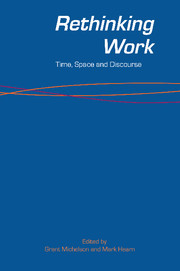Book contents
- Frontmatter
- Contents
- Tables and Figure
- Contributors
- Editorial Statement
- Abbreviations
- 1 Going to a New Place
- PART I TIME
- PART II SPACE
- 7 Union Power
- 8 Globalisation and Labour Mobility
- 9 A Spatial Perspective on International Work and Management
- 10 Markets and the Spatial Organisation of Work
- PART III DISCOURSE
- COMMENTARY
- Index
7 - Union Power
Space, Structure, and Strategy
Published online by Cambridge University Press: 05 June 2012
- Frontmatter
- Contents
- Tables and Figure
- Contributors
- Editorial Statement
- Abbreviations
- 1 Going to a New Place
- PART I TIME
- PART II SPACE
- 7 Union Power
- 8 Globalisation and Labour Mobility
- 9 A Spatial Perspective on International Work and Management
- 10 Markets and the Spatial Organisation of Work
- PART III DISCOURSE
- COMMENTARY
- Index
Summary
For most of the ‘boom years’ from soon after the end of the Second World War to the economic crises of the 1970s, Australian unions, like those in so many other market societies, enjoyed high levels of membership and apparently entrenched power. In this world, different from the old capitalism which preceded it and the new one which has followed it, the social institutions that made ‘industrial relations’ were consolidated after what had been a much less certain period before the war. Collective bargaining and workers' unions were central elements of this world, but today they are both under threat. Membership has collapsed from postwar highs; individualism tramples over collectivism.
This chapter sets out an argument about the present union crisis. Contrary to much orthodoxy, we argue that Australian unionism has undergone immense change in the recent past. Many things point to this: the corporatist Accord with the national Labor government, the rationalisation of unions through amalgamation, the adoption of organising strategies. The membership base has been transformed, such that over 42 per cent of all unionists are women, a figure more or less in line with the gender division of the paid workforce. Unlike other countries, there are no ethnic and racial groups conspicuously excluded from the union movement. Nevertheless, union power and membership remain, quite clearly, in crisis.
The chapter draws on the human geographers and the industrial relations researchers who see unions as agents of their own history and argue that unions themselves hold the key to their survival.
- Type
- Chapter
- Information
- Rethinking WorkTime, Space and Discourse, pp. 123 - 143Publisher: Cambridge University PressPrint publication year: 2006
- 5
- Cited by



